Table of Contents
Content marketing and finance have a lot in common.
Just like investing is about consistent, long-term growth, search engine optimization (SEO) is about building sustainable visibility for your brand that pays off over time.
These results don’t come easily in finance. The reality is that the industry is competitive, there’s a lot of red tape, and users are hesitant to trust you.
But — if you know how to do it right, the impact of content marketing can be massive.
In this post, we explain nine strategies financial services brands, fintech companies, and banks can use to rethink and overhaul their content marketing efforts, with detailed examples so you can see the results in action.
9 Effective Content Marketing Strategies for Financial Services Brands
The following content marketing tips are based on North Star Inbound’s work with financial services companies and the strategies we’ve used that have had the most impact for our clients.

1. Use Author Profiles to Demonstrate Experience, Expertise, Authoritativeness, and Trustworthiness (EEAT)
First, let’s dispel a myth that exists in SEO.
Google is not working against you. You don’t need to trick the algorithm or have an already established brand to rank content in a “Your Money or Your Life” (YMYL) industry like finance.
You just need to build trust with users. And show Google that you’re doing it naturally.
We’ve been helping clients create content that satisfies Google’s E-A-T requirements (expertise, authoritativeness, and trustworthiness) for years. And now that an extra E has been added (for “experience”), we’ve evolved our methods.
EEAT is a complex puzzle, and the first step to solving it is to show that your content is written by individuals who:
- Have first-hand experience with the subject matter (experience)
- Have the credentials to be a reliable source (expertise)
- Have a positive reputation in the industry (authoritativeness)
- Cite trusted sources and publish on a secure site (trustworthiness)
One way to send positive EAAT signals to Google (with a focus on expertise) is to do more than create simple author bios on your site. And if you’re still using fake “personas,” to go way beyond that.
Instead, create and display detailed profiles of your authors on each piece you publish, and have every article reviewed by someone who meets all the criteria above.
Here’s a perfect example from established brand NerdWallet.com that smaller companies can emulate:
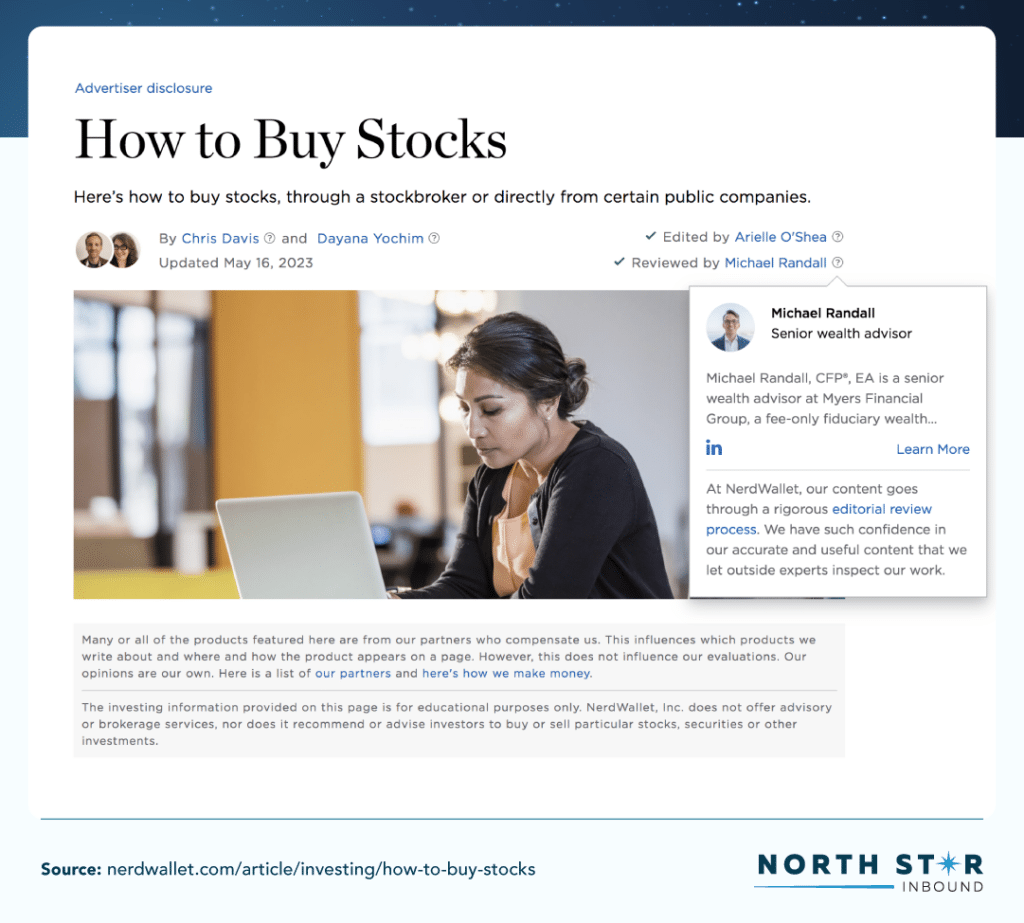
Notice how the detailed profiles of the authors, the editor, and the reviewer explain their experience and certifications and link to their LinkedIn accounts.
There’s an explanation of the site’s editorial review process, and links to its advertising disclosure, affiliate policy, and a disclaimer — all above the fold. This is the sort of strong E-E-A-T signal that Google loves, and users naturally feel confident in.
Of course, to pull this off effectively you need to find the right content creators and reviewers, and that’s easier said than done.
If your client doesn’t have in-house subject matter experts (or the SMEs don’t have time to review your content), try sourcing reviewers from your professional network on Linkedin or using platforms to find qualified freelancers. If you need buy-in to get the resources, present Google’s own Quality Rater Guidelines and explain how being seen as trustworthy and authoritative aligns with broader brand objectives.
2. Analyze and Cite Credible Sources
The need for high-quality content has been discussed at length in the SEO community. What isn’t talked about as much is how accurate, high-quality content is built on a foundation of thorough research.
Many search engine results pages (SERPs) for finance queries are populated with articles by writers who thought topic research meant reading and regurgitating the top 3 results.
When you borrow facts and commentary from top-ranking competitors, not only do you fail to offer any real insight to set your brand apart, but you risk copying incorrect information. A lot of finance SERPs are just echo chambers of inaccuracies.
Thankfully, this presents an opportunity.
Take the time to find primary sources for your information, and analyze them in depth with user intent for the keyword you’re targeting in mind. This will help you discover new angles on topics so the content is directly relevant to your audience.
For added impact, show where you sourced the information from. When creating content for Self Financial, North Star Inbound adds primary sources for every fact cited to ensure accuracy. Users can then check the information themselves.

A list of all sources is included at the end of the article. Showing the exact URL and date it was accessed demonstrates transparency and also helps internal teams keep content updated to maintain its value over time.

The websites shown above are all reputable primary sources in the industry, such as credit bureaus, or .gov resources. You can also use .edu sites and reliable industry journalism.
Showing where you sourced your information from and offering a unique perspective on the primary source boosts your E-E-A-T and proves to users that they can trust you with their money — evidence of truly high-quality content.
3. Source Unique Data to Position Yourself as a Thought Leader
Credibility is crucial in finance — not just for building authority in the eyes of Google, but for making users feel secure using your product or services. However, it’s easy for smaller financial services brands to get left behind in the SERPs by fierce industry competition with larger budgets.
It’s a catch-22. How do you build credibility without visibility, and vice versa?
Here’s how: Become a thought leader.
When you share unique insights, you grow your influence. And by promoting and sharing this content, you build authoritative backlinks, which are one of the strongest SEO signals you can send to Google.
Let’s see this in action. Here’s an example of North Star Inbound’s digital PR work for Forbes Advisor:

To create this article, we gathered unique data by surveying over 1,000 millennial and Gen Z adults in the U.S. about whether they had gotten financial advice from social media.
The results revealed that 79% of people from these generations had gotten advice from platforms like YouTube, Reddit, and TikTok — illustrating the power of these channels for financial services brands.
When you share valuable insights like this, people listen. The article earned 291 total links from high-authority sites, such as Fool.com, ABC News, as well as other local and national news sites and reputable industry publications.
Becoming a thought leader doesn’t happen overnight. From our experience, it requires time and these three key traits:
- Expertise: Thought leaders invariably have an in-depth understanding of their field.
- Vision: It’s important to stay ahead of the latest trends in your industry and have one eye firmly fixed on the future.
- Creativity: Ideating shareable content is an art form. You need to be able to discern what is useful data as well as offer an imaginative spin on it.
Sourcing the data and creating the content that positions your brand as a thought leader is admittedly time and resource intensive if you’re starting from scratch. Which is one good reason to form partnerships to take advantage of established processes.
4. Target Customers at Different Stages of Their Buyer Journey
In the financial services industry, creating content that resonates with users at different stages of their buyer journey allows you to build a relationship with them based on trust.

The journey a user takes from learning about a topic to purchasing a product can be visualized using the content marketing funnel. Because the user flows through these three main parts of the funnel, effective SEO-optimized content needs to target each one:
- Awareness (top of the funnel): Content that attracts new users by answering broad questions they have about a topic, such as informational blog posts
- Consideration (middle of the funnel): Content that helps users form a more in-depth understanding of a topic, such as how-to guides and direct comparisons
- Decision (bottom of the funnel): Content that positions your product as a solution to the user’s problem, such as product overviews and reviews
Here’s an example of each from Self Financial:
Awareness (top of the funnel)
In the blog post How to Rebuild Your Credit, Self answers a common question users may have about credit and helps build their financial knowledge. The audience is aware they have bad credit, but now what? Topics like this can funnel users to middle funnel or bottom funnel pages as they understand solutions and get ready to take action.
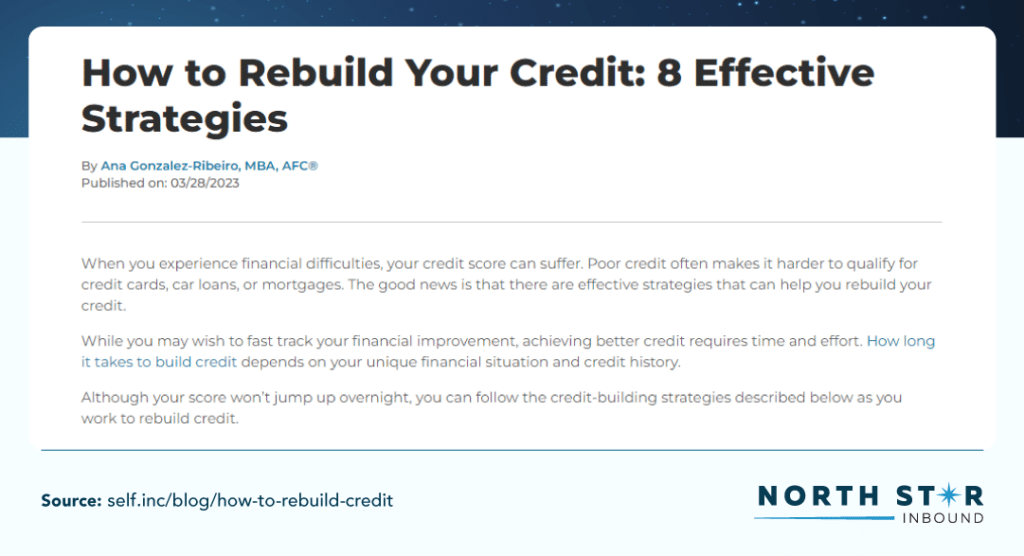
Consideration (middle of the funnel)
In What is a Credit Builder Loan?, Self provides unbiased information for users who are researching and comparing solutions. The audience understands that credit builder loans might be a solution to their problem, but want to learn more before making a decision.

Decision (bottom of the funnel)
Self’s Self vs. MoneyLion page directly compares the company’s offering to one of its key competitors, giving a balanced perspective but also showcasing the benefits of its own product.
By this point, users have entered the funnel with a general question about improving their credit, learned about potential solutions, and compared Self’s products to other options. Now they’re potentially ready to convert.
No blog post is an island — each piece of content you create connects to and builds on others in the funnel.
Planning a content strategy with the user’s journey in mind from the beginning not only has a huge potential impact on ROI, but allows you to build a website that users consistently trust, return to, and recommend to others.
If you plan to work with an agency for your content strategy, be sure to discuss how they target users at different stages of the funnel.
5. Clearly Answer the User’s Question to Win Featured Snippets
Most SEO-optimized content has one ultimate goal: to answer the user’s question.
Providing clear answers is especially important in finance, where users need complex topics distilled into simple and actionable information.
One way to do this is to meet the user’s “search intent” right away — that is, determine what question is at the heart of the user’s query, and provide a direct answer at the top of the page so they don’t have to dig through the piece to find what they’re looking for.
By answering questions directly, you can also win Featured Snippets. These are quick answer boxes at the top of the SERP that satisfy the user’s query without them needing to read a full article.
Here’s an example for the query “How to check credit score with ITIN number”:
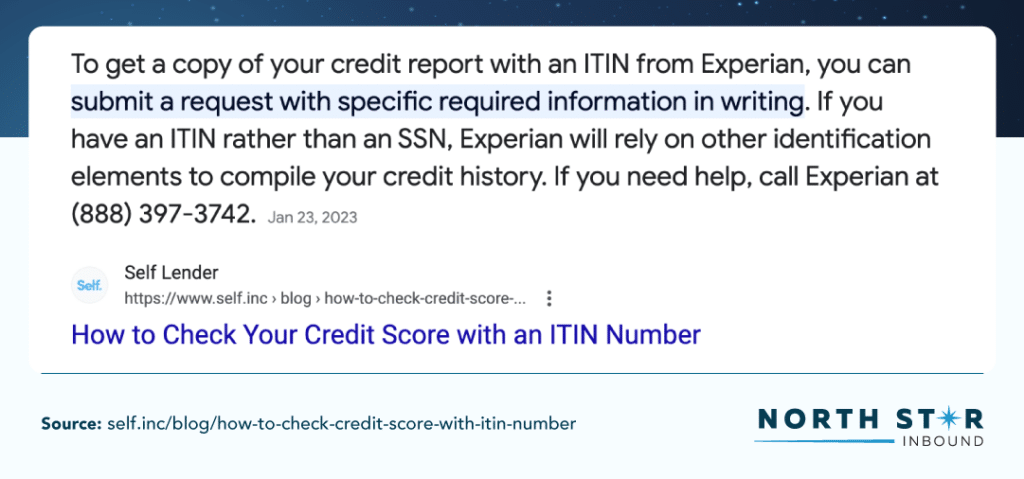
Featured Snippets are critical SERP real estate, and ranking for them increases brand awareness and authority and increases impressions and clicks.
Follow this quick formula for winning feature snippets for the keywords you’re targeting:
- Answer directly with the same syntax as the question in the first sentence.
- Elaborate on the answer by providing more detail.
- Expand the answer further by providing additional information users may need to know next.
To solidify your strategy, highlight opportunities to target featured snippets in your content briefs. A good way to find questions that people are asking is to look at the People Also Ask (PAA) box.
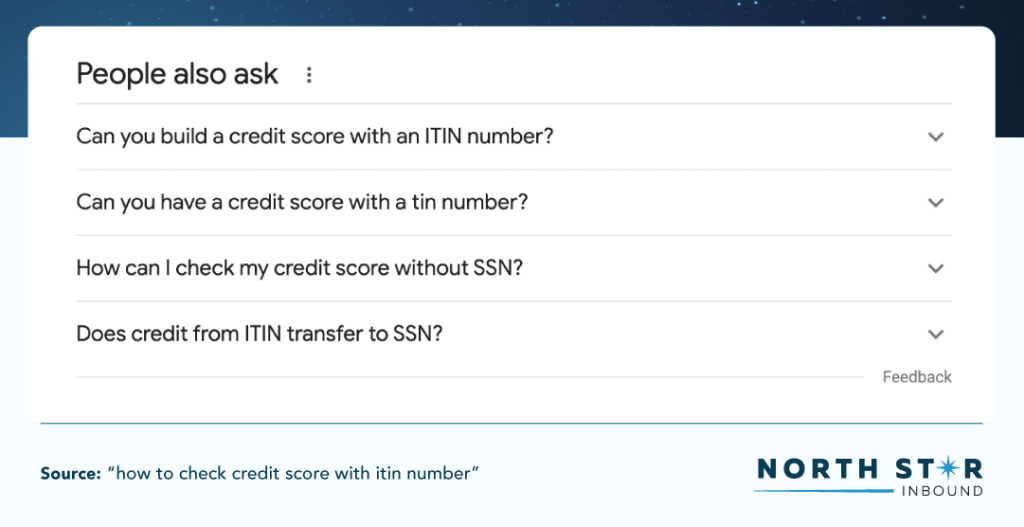
Use relevant questions that people are asking to build a more detailed picture of the user’s search intent so your content answers all their questions throughout.
6. Build Topical Authority
Finance is a competitive niche populated with serious players. It may seem like your competitors have covered every keyword imaginable.
But here’s something that they may not have considered, but Google has: topical authority.
This concept refers to when a website covers one (or more) topics in depth from every angle, instead of randomly targeting unrelated keywords. The difference is depth not breadth.
When a site has a comprehensive body of interconnected high-quality content on one topic, it shows both users and Google that it’s a trusted source on that subject. A site with good topical authority can outperform much larger or well-established sites.
It may seem like your competitors are everywhere — but really they just lack focus. By focusing on one topic at a time, you can build the topical authority that they don’t have, and soon overtake them in the SERPs.
Here are two steps you can take right now to build topical authority:
1. Research topics as well as keywords
Perform in-depth keyword research into a topic and find all the points of discussion. You should be able to identify a central topic as well as numerous subtopics.
Group these keywords together by search intent by seeing if they show a similar SERP.
2. Structure your content with a hub and spoke model and interlink
Now you have keywords organized around a central topic and various narrower subtopics, you can structure your content using a hub and spoke model.
Create a “hub” page for the central topic you want to build authority around and publish pages discussing the subtopics as the “spokes” supporting it.
Make sure all the spoke (subtopic) pages link to each other and link back up to the hub page to pass the authority between pages.
Consider this example from North Star Inbound’s Content strategy for Self Financial:

Structuring your content with this model and targeting longtail keywords in subtopics shows Google that you have organized, comprehensive information and are an authority on the central topic.
Plus, using the hub and spoke model creates a site that’s easy for users to navigate and for Google to crawl through.
7. Drive Qualified Traffic to Get More Conversions
Ready for another industry secret?
Most SEO teams are focused solely on driving more organic traffic. That’s part of the job description. But unless you’re relying on ad revenue, chasing traffic is a means to an end — the real goal is to get more users to convert.
You can radically improve your conversion rate if instead you think about traffic as either:
- Qualified: Users who are more likely to fit your target demographic and are coming with a strong interest in or need for your product or service.
- Unqualified: Users who arrive incidentally or through irrelevant search terms and are unlikely to convert.
When you start focusing on only driving qualified traffic, everything changes. Every piece of content earns its place and you get more results with fewer resources.
Here’s how to create content that is targeted at the right people:
- Create a user persona. It’s impossible to write for your target audience if you don’t know who your right audience is. Use your analytics data to gain insight into the demographics of your customers, their behaviors, and their needs. Build a persona around this so you know who you’re targeting and what their pain points are.
- Choose relevant keywords. By understanding your target audience you can better understand how and why they search and select topics and keywords that are relevant to them. Base your keyword research on solving your ideal customer’s problems and analyze the search intent of each query to see if or where the keyword fits in your funnel.
- Utilize SEO tools. Some keywords offer more return than others. Use SEO tools like AHREFS and SEMRush to understand how difficult a keyword is to rank for and how much traffic it could bring in.
At North Star Inbound, we go one step further. We closely analyze our client’s data to see which topics are already driving action, and lean into that. For Self Financial, that means the topics that lead to sign-ups and new credit builder accounts opened.
It’s like seeing the Matrix. Suddenly your content strategy is viewed through a new lens — one that actually makes you more money.
Once you have this information, go forth and create the content that qualified users want, plus any supplementary resources they need, from whitepapers, to interactive content like webinars, and podcasts.
8. Defeat Red Tape With Detailed Editorial Guidelines
Publishing financial content may seem like navigating a minefield.
You may encounter in-house compliance requirements or external regulations, such as those of the Financial Industry Regulatory Authority (FINRA).
After considerable time and resources have been spent on detailed research and expert perspectives, it’s not unusual for content to get tangled in red tape and held up with revision requests.
Our solution to this common issue requires a little more effort upfront, but it’s worth it:
Create detailed editorial guidelines. These should be a living document that is revised and updated with each piece that is published.
North Star Inbound collaborated closely with Self Financial’s in-house compliance team to develop a set of guidelines that allowed us to consistently deliver accurate content in the client’s preferred tone and voice.
Here’s an example:

Each piece of content went through a multi-step editorial review including specific compliance edits to ensure it conveyed the client’s message in the brand’s style and met all internal and external requirements.
We were able to implement this efficiently by following these steps:
- Emphasize compliance in every step of the content process.
- Create detailed content briefs that refer back to the guidelines and compliance notes.
- Train content writers to discuss financial topics with a journalistic eye and without fluff.
- Constantly revise based on compliance feedback.
A degree of red tape is the reality of financial services, but there’s no reason you shouldn’t be prepared and adapt your editorial practices accordingly.
9. Capture the Image Pack
Many complex financial queries are best answered visually.
When questions can be answered with an image, Google typically shows an image pack at the top of the SERP. Much like winning a featured snippet, appearing in the image pack has a huge impact on impressions and clicks.
Here’s an example for the keyword “credit report example”:

There is a clear visual intent for the query and users want to see an easy-to-parse image of a credit report to help them navigate their own. Self Financial offers a visually appealing design asset that includes everything users need.
An added benefit of this strategy is that you may be able to rank in the image pack for a keyword you wouldn’t be able to rank an article for.
For example, Self appears in the image pack for the keyword “what is apr,” which has 63,000 monthly searches. The brand wouldn’t be able to rank alongside Investopedia and Bank of America with an article, but offering a visual asset allows them to share much of the same visibility in the SERP.
To capture the image pack, create professionally designed assets in formats such as infographics to illustrate key parts of your content that are better simplified with images.
Below you can see how Self Financial captures the first two places in the image search by offering the best answer for the aforementioned query, and another relevant Self asset captures the first related image search in the carousel above.
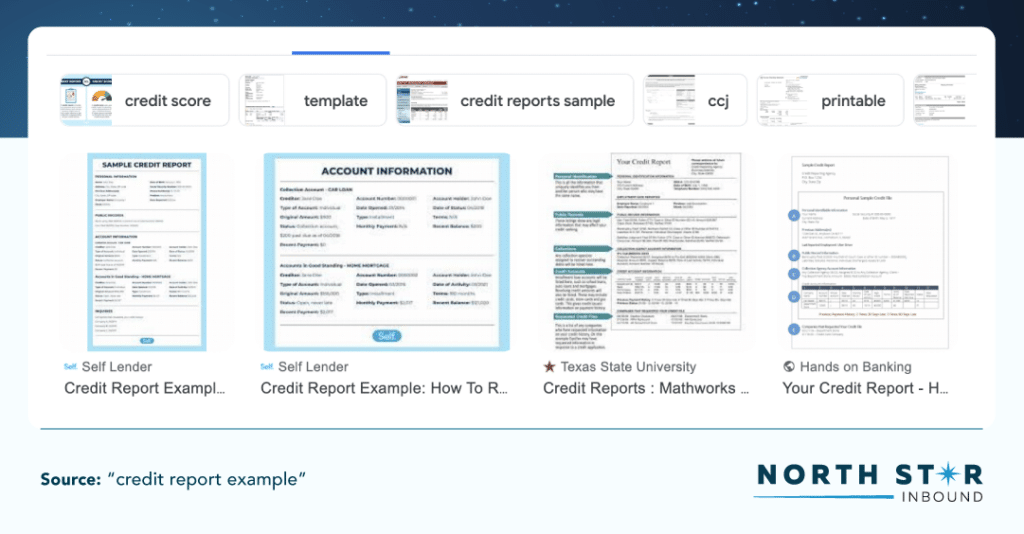
For consistent results, develop an in-house style that fits your brand and aim to include two to three visual assets per article.
Why Content Marketing Is Crucial in the Financial Sector
Digital marketing has revolutionized the financial services sector because it offers so many new ways to educate customers and build relationships with them.
Building Trust with Customers
The financial sector is essentially built on trust because choosing the wrong financial products can have serious consequences for a person’s life.
One of the benefits of content marketing is that it allows you to build trust naturally by communicating transparency, honesty, and ethical practices. Think of it as: show, not tell.
Providing resources that solve users’ problems without explicitly promoting your product builds trust, which is especially important for younger generations who grew up with digital advertising.
Establishing Your Brand as an Authority
Finance as a niche is fiercely competitive and building authority is vital to stand out. You can showcase your authority by creating a body of interconnected content that accomplishes all of the following:
- Is built on primary sources
- Engages users
- Answers their questions
Building links to that content from other reputable industry sites confirms your authority, and with authority comes confident customer decisions, customer retention, and loyalty that leads to referrals.
Providing Value by Simplifying Complex Topics
Your potential customers are likely not financial experts. They’re ordinary people navigating complex new concepts, and they appreciate an honest, direct answer to their questions.
Define jargon in your content, and create simple how-to guides, checklists, and FAQs that make finance less intimidating. Accessibility broadens the demographics you attract as people with different levels of financial literacy discover your resources.
Demystifying financial topics for users without condescending to them educates and empowers people — thereby demonstrating your expertise to Google and building a funnel of content that yields increasing rewards over time.
Navigating the Future of Financial Services Content Marketing
With the rise of AI technology such as ChatGPT, both the financial sector and content marketing as a discipline are currently in a state of flux.
While it’s uncertain how AI will eventually shape the future of our two industries, what is evident now is the importance of staying up-to-date with how this technology affects marketing trends in order to maintain a competitive edge.
Google’s generative AI restricts how many AI answers it generates for YMYL topics such as finance, showing that this is a topic best addressed by real-life experts, not machines. Results are changing moment to moment so it’s vital to stay up to date.
While some brands may elect to create generic AI content to save on costs, we firmly believe a human touch is becoming increasingly valuable to both users and Google’s algorithm.
Implementing These Strategies for Your Brand
The strategies detailed in this post were key to how North Star Inbound drove 50,000+ organic visits from our content for Self Financial.
If you’re looking for a content marketing agency with a proven track record to implement these strategies for you, get in touch today to see how we can help.





